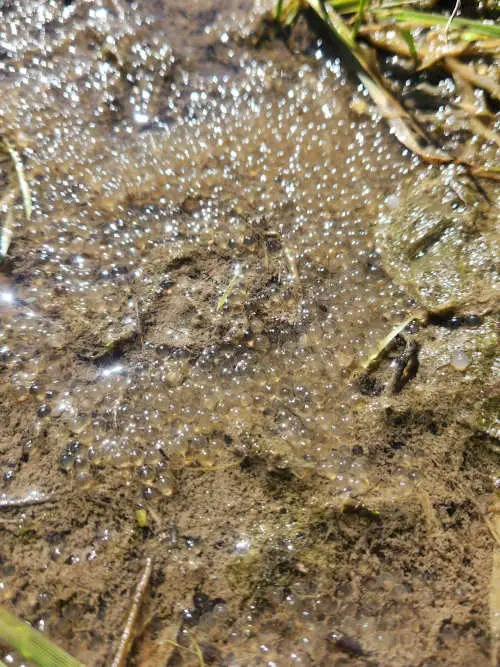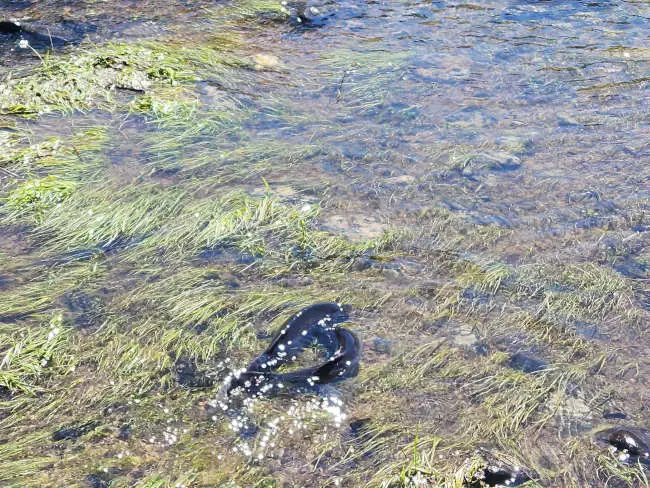
Dear Lady of the Lake,
I hear the Clear Lake hitch had hard time during the drought years. How are they doing now since we had so much rain? Where are they spawning and how can we help them? I wrote to you before, thanks for your column.
- Hans, again asking how are the Hitch -
Hi Hans,
Thanks for writing this in! It’s a great time to talk about the Clear Lake Hitch.
If any reader needs to get caught up, you can read the “How about the Hitch” part 1 column from January 2022.
For those of you interesting in some of the science and management planning for this species, I suggest you watch out Water Quality Wednesday, hosted by the County of Lake Water Resources, from January 2022 available below.
The scientific name of the Clear Lake hitch is Lavinia exilicauda chi, and the native indigenous peoples of Clear Lake (the Hinthil, Gowk Xabatin, or the Pomo) refer to the fish as “chi” (pronounced CH-eye). The chi is a very culturally important fish to the Pomo and other indigenous native peoples of the Clear Lake area. The chi serves as a main food staple, providing a vital source of protein and nutrients, and easy to catch as the fish prefer shallow, warm, and slow-moving water, ideal to the shores and sloughs along the edges of Clear Lake.
Chi love to inhabit shallow waters full of submergent and emergent aquatic plants, in areas with sandy or gravel bottoms. Here is where they feed on algaes, aquatic insects and terrestrial insects that rest on the surface of the water, as well as crustaceans.
Right now, the chi are spawning in the shallow, flowing tributaries that connect to Clear Lake. The earliest spawning chi were observed in Cole Creek, then Adobe and Kelsey Creek, then Manning and Forbes, and now Middle, Clover, Ally and Lyons Creek.
We even observed chi in creeks around Bachelor Valley, meaning they are swimming up Scotts Creek into Tule Lake, or possibly live in Tule Lake year-round. Chi have historically spawned in all creeks and tributaries around Clear Lake. Even some hydromodified or altered drainages that were more pronounced creeks historically, attract the chi, as the fish use temp and olfactory cues to guide them up their home steam when the creeks flow into the lake in spring.
Chi will swim against currents and flows, and jump small barriers to get up stream to preferred spawning grounds. However, chi are no salmon, they are small-bodied and have limits to the heights and velocities they can overcome when swimming in a high-flowing stream.

Preferred spawning areas are usually gravel beds in shallow water and high flow, and eggs will release within a few days of being laid, and fry will feed in the stream and then make their way down to the lake within days, or a couple weeks, after being born.
As one can imagine, being a very small baby fish getting pushed and bounced around in a shallow, flowing stream must be exhausting! Baby hitch are extremely vulnerable to being preyed upon by other fish and wildlife, fluctuating water levels and low oxygen levels when the temperatures start to warm.
Scientifically, the point where chi are born to when they are 1 year old in the lake is the time period we know the least about. Fish biologists, from federal, state, and local tribal agencies, have indicated a large knowledge gap during this time period when it comes to the chi.
Chi populations and abundances have steadily declined the last few decades, with declines being noted by local residents, tribes, and the California Department of Fish and Wildlife (CDFW). Recent population estimates and catch counts, conducted by several state and federal agencies, have fluctuated, but in the last five years, sharp declines and little to no recruitment of juvenile Chi has raised some high concerns for this endemic, special minnow fish.
Some of these declines might be attributed to low water levels during drought years, but there might be some other factors that as of now are unknown. These unknown factors are most likely a combination of factors such as habitat fragmentation, degradation, increased stream and lake water temperatures, shorter spring flow years, predation at stream mouths, illegal in-stream water uses and diversions, and water quality impacts in the lake and streams.
Luckily, with high water levels and consistent springtime flows, the Chi looks like they might be having a normal spawning year - but again, if those babies make it to the lake and survive to reproduce themselves is literally, the multi-million dollar question.
In fact the CDFW has pledged significant funds to address hitch barriers in Clear Lake tributaries, but it’s still unknown if that is even enough to recover this species.
Another question, that is definitely more affordable right now, is how can we help the Chi?
How can you help?
There are several easy, free, and simple ways you can help.
First, educate yourself about the Hitch and about lake and stream ecology and biology. When the ecology and biology of this important species is more well-known and understood, then the community as a whole will appreciate and value this species, and be aware of the kinds of activities that have negative impacts on the fish and their habitat.
Feel free to take a walk to a nearby creek or stream and you can probably spot some Chi, but don’t disturb them.
Please do not throw rocks or trash as the Chi, don’t walk, bike, or drive in the creeks until at least after the end of May. Chi lay their eggs in the creek bed, around the edges and among the rocks, so any disturbance may jeopardize eggs and unintentionally kill Chi babies.
Chi do not spawn in all the creeks at the same time, some creeks (Like Cole and Adobe) are early season spawning locations and others (like Scotts, Seigler Canyon, and Copsey) are late season spawning locations.
Do not try to catch the chi. It is actually very illegal to handle the chi without a CDFW permit. If you are a tribal member, there are certain chi cultural allocations for tribes in their designated territories, but if you are not a tribal member utilizing the chi for cultural practice, you are not allowed to touch, catch, pet or relocate the chi, their eggs or their babies.
Some agencies do have CDFW scientific collection permits, which list specific staff from some tribal environmental departments, federal agencies, and Lake County Water Resources, to catch chi when performing rescues and conducting scientific surveys and monitoring efforts.
Sometimes you might see some of these staff in streams, ditches, ponds, wetlands, or the lake, conducting fish monitoring, handling (tagging and releasing) fish. They will have identifying clothing, and specific gear for conducting this work. This gear might include electrofishing backpacks, coolers, buckets, or chest-high waders, or larger nets specific to safely moving fish.
If you are concerned and curious, you can always ask folks where they are from and what task they are doing. Any of the federal, state, local agencies and tribes will be ready and able to provide outreach and education about what they are doing.
If you see unauthorized activity in the creek, stream, or somewhere else, and you suspect some people are harming or catching Chi, and they don’t have a permit, you can call CDFW Cal-Tip line 1 888 334-CALTIP (888 334-2258). The Clear Lake chi is state threatened, so it’s a priority for the CDFW wardens and biologists to ensure the fish is able to live and reproduce safely.
Thanks for your questions Hans, and thanks for caring about the chi. The recovery of this unique species will be slow, but together, with dedicated and caring community-members like you, the Clear Lake Hitch has a bright future.
If you have more questions or need to report stranded or stuck chi/Clear Lake hitch, you can direct them to the Lake County Water Resources Department at 707-263-2344 or through email at This email address is being protected from spambots. You need JavaScript enabled to view it. and they can help answer your questions or get you in touch with someone who can.
According to the new Water Boards Chi website, recent storms have flooded parts of Clear Lake creeks, causing some hitch to be stranded in ditches and on private property. If you see stranded hitch, please note the location and email This email address is being protected from spambots. You need JavaScript enabled to view it. and the information will be forwarded to the local team able to respond.
You can also contact CDFW at 916-591-1152 or through the 24-hour Cal tip line, 888-334-CALTIP (888-334-2258).
The quickest way to get a response on hitch situations is contacting a local tribe. Although all tribes are working together, with CDFW, to monitor chi spawning activity and coordinate rescues when and where they are needed, the general areas are covered by the tribes below.
Lakeport to Kelseyville to Riviera area, contact Big Valley Rancheria Environmental Department: 707-263-3924.
Scotts Creek to Middle Creek Contact Habematolel Pomo of Upper Lake: 707-275-0737.
Areas between Middle Creek down to City of Clearlake contact Robinson Rancheria: 707-530-5320.
Sincerely,
Lady of the Lake
Angela De Palma-Dow is a limnologist (limnology = study of fresh inland waters) who lives and works in Lake County. Born in Northern California, she has a Master of Science from Michigan State University. She is a Certified Lake Manager from the North American Lake Management Society, or NALMS, and she is the current president/chair of the California chapter of the Society for Freshwater Science. She can be reached at This email address is being protected from spambots. You need JavaScript enabled to view it..
Don't forget about the Lady of the Lake Photo Contest! Now accepting lake landscape and wildlife photos. More information and rules are provided in the announcement column https://www.lakeconews.com/news/75101-lady-of-the-lake-announces-photo-contest.

 How to resolve AdBlock issue?
How to resolve AdBlock issue? 





